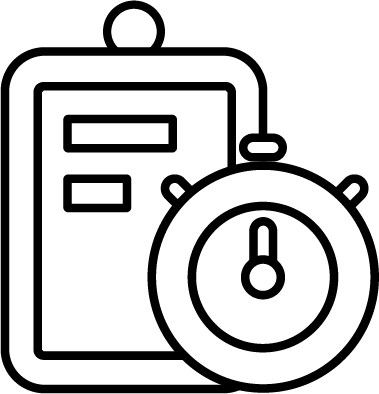Here are some definitions to help you in your investigation.
Measurement - to find the size, length, or amount of something
Liquid - a phase of matter with particles that are very close together and can move slowly to change their positions
Volume - the amount of space an object or substance occupies
Graduated Cylinder - a tool used to measure the volume of a liquid
Meniscus - the curved upper surface of a liquid in a container
Increment Size - the value of the smallest markings on a measuring device
Estimation - a rough determination of the value, quantity, or number of something
Place Value - the value of each digit in a number
Intensive Property - a property that does not depend on the amount of a substance
Extensive Property - a property that does depend on the amount of a substance
Analog - a measuring device that the users has to interpret the measurement reading.
Digital - a measuring device that provides the measurement reading to the user.
Regular Solid - a solid whose area or volume can be measured using its length, height, and width
Irregular Solid - a solid whose area or volume cannot be measured using its length, height, and width
Displacement - to move something from its usual place or position
Milliliters (mL) - a common unit used to measure the volume of an object
Cubic Centimeters (cm3) - a common unit used to measure the volume of an object
Mass - the amount of matter in an object
Weight - the force of gravity pulling an object towards Earth
Solid - a phase of matter with particles very close together and that are not free to change positions with each other
Grams (g) - a common unit used to measure the mass of an object
Kilograms (kg) - a common unit used to measure the mass of an object
How to Read the Mass Using an Analog Device
Instead of showing a number on a screen, an analog scale has a needle that points to different numbers printed around the circle. These numbers tell us the measurement.
1. Look at the numbers: See all those numbers printed in a circle? They usually start from zero and get bigger as you go around. These numbers represent the units we're measuring, like kilograms (kg) for weight.
2. Find the needle: There's a pointy arm, called a needle, that moves as you put something on the scale. When there's nothing on the scale, the needle should usually point to zero.
3. Watch it move: When you put something on the scale, like a rock, the needle will move away from zero and point to a different number.
4. Read the number: The number that the tip of the needle is pointing directly at is your measurement! In the measurement shown, we know the mass is between 6.0 and 6.1 kg.
5. Look closely at the lines: Sometimes the needle doesn't point exactly at a big number. There are smaller lines in between the big numbers. These lines help us get a more precise measurement. You need to figure out what each of these smaller lines means. If there are ten small lines between 6.0 and 6.1, each small line represents 0.01 kilogram.
Count the smaller un-numbered lines and we see the needle points to between 6.07 and 6.08 kg.<br><br>
6. Always estimate one place to the right of the smaller lines. So we estimate the needle to be about 2/10 of the way to the next un-numbered line. We correctly read the mass of the object to be 6.072 kg.
7. Be careful where you look: Make sure you look straight at the scale when you're reading it. If you look from the side, the needle might seem to be pointing to a slightly different number.
)
What is an irregular solid?
Any solid that does not have a shape easily measured by its length, width, height, and depth.
What are SI units?
SI units are standard units of measure of seven specific quantities as defined by the International System of Units (SI). The seven quantities are time, length, mass, electric current, temperature, amount of a substance, and luminous intensity.
What is mass?
Mass is the amount of matter in an object or substance.
What are some common units for measuring mass?
The metric unit for measuring mass is the gram. The SI unit for measuring mass is the kilogram. Any metric prefix attached to the base gram unit is appropriate for measuring the mass of an object or substance. For instance, mg, cg, or ng.
What is volume?
Volume is the amount of space occupied by an object or substance.
What are some common units for measuring volume?
The metric unit for measuring volume is the liter. The SI unit for measuring volume is the cubic meter (m3). Any metric prefix attached to the base liter unit is appropriate for measuring the volume of an object or substance. For instance, mL, cL, or nL. Any metric prefix attached to the base SI unit is appropriate for measuring the volume of an object or substance. For instance, cm3, mm3, or km3,
What is density?
Density is a measure of the compactness of an object or substance. To find the density of an object, the mass of the object is divided by the volume of the object.
What are some common units for measuring density?
The units for density are any standard unit of mass over any standard unit of volume. For instance, grams/cubic centimeter or kilograms per liter.
What is an intensive property?
A physical property that does not depend on the amount of a substance present. For instance, temperature, density, and the hardness of an object do not depend on how much of the object is present.
What is an extensive property?
A physical property that does depend on the amount of a substance present. For instance, the mass and the length of a substance depend on how much of the substance is present. If more of a substance is present, then the substance’s mass changes.
 Is this piece of jewelry pure gold or simply gold plating over some cheaper metal? That’s a question faced by many people when looking at a ring or bracelet. One of the best ways to make this determination is to find the density of the piece of jewelry. However, to find density the volume of the substance must be known, and many objects have irregular shapes where easy measurements with rulers are not possible. Your challenge is to find the mass and volume of an irregular solid and then determine the object’s density.
Is this piece of jewelry pure gold or simply gold plating over some cheaper metal? That’s a question faced by many people when looking at a ring or bracelet. One of the best ways to make this determination is to find the density of the piece of jewelry. However, to find density the volume of the substance must be known, and many objects have irregular shapes where easy measurements with rulers are not possible. Your challenge is to find the mass and volume of an irregular solid and then determine the object’s density.)


